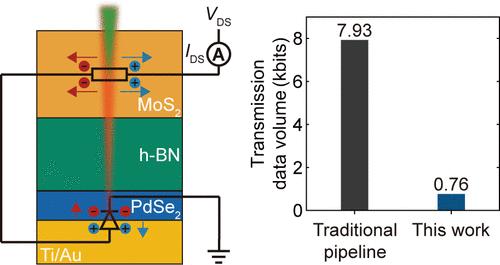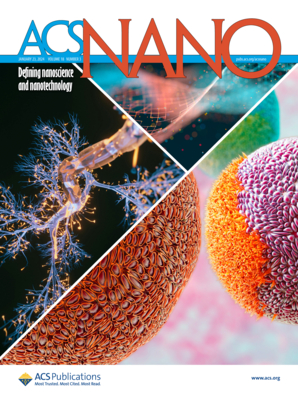IF 15.8
1区 材料科学
Q1 CHEMISTRY, MULTIDISCIPLINARY
引用次数: 0
摘要
红外-可见光融合光电探测为在复杂场景中感知目标提供了巨大潜力。然而,双波段成像本身会产生大量冗余数据,因此迫切需要直接在像素级执行压缩传感。在此,我们报告了一种由 MoS2/h-BN/PdSe2 垂直堆叠异质结构组成的光电探测器,其底部的 PdSe2 通道与顶部的 MoS2 通道之间由一个共用金属电极互连。利用红外光比可见光穿透更深的特性,该光电探测器中的底部 PdSe2/Au 光电肖特基结可以探测红外光,并驱动顶部 MoS2 沟道探测可见光。此外,通过在外部漏极施加电压,输出光电流可根据电压极性进一步增强或抑制。该探测器接收双波段光输入,但只输出一个电信号,从而实现了像素内双波段相互关联的压缩传感。驱动可见光光响应的红外光响应物理过程直接发生在探测器内,从而能够根据像素级的红外辐照强度过滤和提取感兴趣的目标。这项工作为复杂环境下的多光谱光学信息压缩传感和处理提供了一种紧凑、节能的解决方案。本文章由计算机程序翻译,如有差异,请以英文原文为准。

In-Pixel Dual-Band Intercorrelated Compressive Sensing Based on MoS2/h-BN/PdSe2 Vertical Heterostructure
Infrared-visible fused photodetection presents significant potential for target perception in complex scenarios. However, dual-band imaging inherently generates a considerable amount of redundant data, highlighting a pressing need to perform compressive sensing directly at the pixel level. Here, we report a photodetector composed of a MoS2/h-BN/PdSe2 vertically stacked heterostructure with a common metal electrode interconnecting the bottom PdSe2 channel with the top MoS2 channel. By exploiting the property that infrared light can penetrate deeper than visible light, the bottom PdSe2/Au photovoltaic Schottky junction in this photodetector can detect the infrared light and drive the top MoS2 channel able to detect the visible light. Moreover, by applying voltage at the external drain terminal, the output photocurrent can be further enhanced or suppressed depending on the voltage polarity. The detector receives dual-band optical inputs but outputs only a single electrical signal, allowing for in-pixel dual-band intercorrelated compressive sensing. The physical process of infrared photoresponse that drives the visible photoresponse occurs directly within the detector, enabling the filtration and extraction of targets of interest based on the intensity of infrared irradiation at the pixel level. This work offers a compact and energy-efficient solution for multispectral optical information compressive sensing and processing in complex environments.
求助全文
通过发布文献求助,成功后即可免费获取论文全文。
去求助
来源期刊

ACS Nano
工程技术-材料科学:综合
CiteScore
26.00
自引率
4.10%
发文量
1627
审稿时长
1.7 months
期刊介绍:
ACS Nano, published monthly, serves as an international forum for comprehensive articles on nanoscience and nanotechnology research at the intersections of chemistry, biology, materials science, physics, and engineering. The journal fosters communication among scientists in these communities, facilitating collaboration, new research opportunities, and advancements through discoveries. ACS Nano covers synthesis, assembly, characterization, theory, and simulation of nanostructures, nanobiotechnology, nanofabrication, methods and tools for nanoscience and nanotechnology, and self- and directed-assembly. Alongside original research articles, it offers thorough reviews, perspectives on cutting-edge research, and discussions envisioning the future of nanoscience and nanotechnology.
 求助内容:
求助内容: 应助结果提醒方式:
应助结果提醒方式:


